Training MixtureOfSVGPExperts on the Motorcycle Data Set (with two experts)¶
This notebook is a basic example of configuring and training a Mixture of Gaussian Process Experts (using MixtureOfSVGPExperts) on the motorcycle dataset with two experts. Instantiating the model with two experts is a special case because only a single gating function is needed (not two!) and the gating network can be calculated in closed form, which is not the case when using more than two experts.
[1]:
import numpy as np
import gpflow as gpf
import tensorflow as tf
import matplotlib.pyplot as plt
import pandas as pd
from IPython.display import clear_output
from gpflow import default_float
from gpflow.utilities import print_summary
from gpflow.likelihoods import Bernoulli
from mogpe.experts import SVGPExperts, SVGPExpert
from mogpe.gating_networks import SVGPGatingNetwork
from mogpe.mixture_of_experts import MixtureOfSVGPExperts
from mogpe.training import training_tf_loop
from mogpe.helpers.plotter import Plotter1D
Let’s start by loading the motorcycle dataset and plotting it to see what we’re dealing with.
[2]:
def load_mcycle_dataset(filename='../data/mcycle.csv'):
df = pd.read_csv(filename, sep=',')
X = pd.to_numeric(df['times']).to_numpy().reshape(-1, 1)
Y = pd.to_numeric(df['accel']).to_numpy().reshape(-1, 1)
X = tf.convert_to_tensor(X, dtype=default_float())
Y = tf.convert_to_tensor(Y, dtype=default_float())
print("Input data shape: ", X.shape)
print("Output data shape: ", Y.shape)
# standardise input
mean_x, var_x = tf.nn.moments(X, axes=[0])
mean_y, var_y = tf.nn.moments(Y, axes=[0])
X = (X - mean_x) / tf.sqrt(var_x)
Y = (Y - mean_y) / tf.sqrt(var_y)
data = (X, Y)
return data
[3]:
data_file = '../data/mcycle.csv'
dataset = load_mcycle_dataset(filename=data_file)
X, Y = dataset
num_data, input_dim = X.shape
output_dim = Y.shape[1]
plt.scatter(X, Y)
Input data shape: (133, 1)
Output data shape: (133, 1)
2021-12-08 18:27:42.245992: I tensorflow/core/platform/cpu_feature_guard.cc:142] This TensorFlow binary is optimized with oneAPI Deep Neural Network Library (oneDNN) to use the following CPU instructions in performance-critical operations: AVX2 FMA
To enable them in other operations, rebuild TensorFlow with the appropriate compiler flags.
[3]:
<matplotlib.collections.PathCollection at 0x19f6aad60>
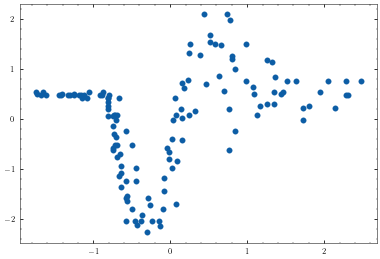
Given this data set, let’s specify some of the model and training parameters. It is clear that there is a low noise, long lengthscales function at \(x<-1\) and at \(x>-1\) the noise increases and the lengthscale shortens. With this knowledge, let’s initialise expert one with a short lengthscale and expert two with a longer lengthscale. We specify each expert to have 6 inducing points and the gating network to have 7 inducing points.
[4]:
num_experts = 2
experts_lengthscales = [1.0, 10.0] # lengthsales for expert 1 and 2
num_inducing_expert = 6 # number of inducing points for each expert
num_inducing_gating = 7 # number of inducing points for gating network
num_samples = 1 # number of samples to draw from variational posterior in ELBO
batch_size = 16
learning_rate = 0.01
In order to initialie the MixtureOfSVGPExperts class for two experts we must pass it an instance of SVGPExperts and an instance of SVGPGatingNetwork with a Bernoulli likelihood. Let’s start by creating an instance of SVGPExperts. To do this we must first create two SVGPExpert instances and pass them as a list to SVGPExperts. Let’s create out first expert.
[5]:
def init_expert(lengthscales=1.0, kernel_variance=1.0, noise_variance=1.0):
idx = np.random.choice(range(num_data), size=num_inducing_expert, replace=False)
inducing_variable = X.numpy()[idx, ...].reshape(-1, input_dim)
inducing_variable = gpf.inducing_variables.InducingPoints(inducing_variable)
mean_function = gpf.mean_functions.Constant()
likelihood = gpf.likelihoods.Gaussian(noise_variance)
kernel = gpf.kernels.RBF(lengthscales=lengthscales, variance=kernel_variance)
return SVGPExpert(kernel,
likelihood,
mean_function=mean_function,
inducing_variable=inducing_variable)
[6]:
experts_list = [init_expert(lengthscales=experts_lengthscales[k]) for k in range(num_experts)]
We can now create an instance of SVGPExperts by passing our two experts as a list.
[7]:
experts = SVGPExperts(experts_list)
print_summary(experts, fmt="notebook")
| name | class | transform | prior | trainable | shape | dtype | value |
|---|---|---|---|---|---|---|---|
| SVGPExperts.experts_list[0].mean_function.c | Parameter | Identity | True | (1,) | float64 | [0.] | |
| SVGPExperts.experts_list[0].kernel.variance | Parameter | Softplus | True | () | float64 | 1.0 | |
| SVGPExperts.experts_list[0].kernel.lengthscales | Parameter | Softplus | True | () | float64 | 1.0 | |
| SVGPExperts.experts_list[0].likelihood.variance | Parameter | Softplus + Shift | True | () | float64 | 1.0 | |
| SVGPExperts.experts_list[0].inducing_variable.Z | Parameter | Identity | True | (6, 1) | float64 | [[-1.74116353... | |
| SVGPExperts.experts_list[0].q_mu | Parameter | Identity | True | (6, 1) | float64 | [[0.... | |
| SVGPExperts.experts_list[0].q_sqrt | Parameter | FillTriangular | True | (1, 6, 6) | float64 | [[[1., 0., 0.... | |
| SVGPExperts.experts_list[1].mean_function.c | Parameter | Identity | True | (1,) | float64 | [0.] | |
| SVGPExperts.experts_list[1].kernel.variance | Parameter | Softplus | True | () | float64 | 1.0 | |
| SVGPExperts.experts_list[1].kernel.lengthscales | Parameter | Softplus | True | () | float64 | 10.0 | |
| SVGPExperts.experts_list[1].likelihood.variance | Parameter | Softplus + Shift | True | () | float64 | 1.0 | |
| SVGPExperts.experts_list[1].inducing_variable.Z | Parameter | Identity | True | (6, 1) | float64 | [[-0.71690236... | |
| SVGPExperts.experts_list[1].q_mu | Parameter | Identity | True | (6, 1) | float64 | [[0.... | |
| SVGPExperts.experts_list[1].q_sqrt | Parameter | FillTriangular | True | (1, 6, 6) | float64 | [[[1., 0., 0.... |
Lovely stuff. We now need to create an instance of SVGPGatingNetwork with a Bernoulli likelihood. Remember that we only need a single gating function for the two expert case. Let’s go ahead and create our gating function and use it to construct our gating network.
[8]:
def init_gating_network():
idx = np.random.choice(range(num_data), size=num_inducing_gating, replace=False)
inducing_variable = X.numpy()[idx, ...].reshape(-1, input_dim)
inducing_variable = gpf.inducing_variables.InducingPoints(inducing_variable)
mean_function = gpf.mean_functions.Zero()
kernel = gpf.kernels.RBF()
return SVGPGatingNetwork(kernel,
likelihood=Bernoulli(),
inducing_variable=inducing_variable,
mean_function=mean_function)
[9]:
gating_network = init_gating_network()
print_summary(gating_network, fmt="notebook")
| name | class | transform | prior | trainable | shape | dtype | value |
|---|---|---|---|---|---|---|---|
| SVGPGatingNetwork.kernel.variance | Parameter | Softplus | True | () | float64 | 1.0 | |
| SVGPGatingNetwork.kernel.lengthscales | Parameter | Softplus | True | () | float64 | 1.0 | |
| SVGPGatingNetwork.inducing_variable.Z | Parameter | Identity | True | (7, 1) | float64 | [[-0.56402756... | |
| SVGPGatingNetwork.q_mu | Parameter | Identity | True | (7, 1) | float64 | [[0.... | |
| SVGPGatingNetwork.q_sqrt | Parameter | FillTriangular | True | (1, 7, 7) | float64 | [[[1., 0., 0.... |
We now have all the components to construct our MixtureOfSVGPExperts model so let’s go ahead and do it.
[10]:
model = MixtureOfSVGPExperts(gating_network=gating_network,
experts=experts,
num_samples=num_samples,
num_data=num_data)
print_summary(model, fmt="notebook")
| name | class | transform | prior | trainable | shape | dtype | value |
|---|---|---|---|---|---|---|---|
| MixtureOfSVGPExperts.gating_network.kernel.variance | Parameter | Softplus | True | () | float64 | 1.0 | |
| MixtureOfSVGPExperts.gating_network.kernel.lengthscales | Parameter | Softplus | True | () | float64 | 1.0 | |
| MixtureOfSVGPExperts.gating_network.inducing_variable.Z | Parameter | Identity | True | (7, 1) | float64 | [[-0.56402756... | |
| MixtureOfSVGPExperts.gating_network.q_mu | Parameter | Identity | True | (7, 1) | float64 | [[0.... | |
| MixtureOfSVGPExperts.gating_network.q_sqrt | Parameter | FillTriangular | True | (1, 7, 7) | float64 | [[[1., 0., 0.... | |
| MixtureOfSVGPExperts.experts.experts_list[0].mean_function.c | Parameter | Identity | True | (1,) | float64 | [0.] | |
| MixtureOfSVGPExperts.experts.experts_list[0].kernel.variance | Parameter | Softplus | True | () | float64 | 1.0 | |
| MixtureOfSVGPExperts.experts.experts_list[0].kernel.lengthscales | Parameter | Softplus | True | () | float64 | 1.0 | |
| MixtureOfSVGPExperts.experts.experts_list[0].likelihood.variance | Parameter | Softplus + Shift | True | () | float64 | 1.0 | |
| MixtureOfSVGPExperts.experts.experts_list[0].inducing_variable.Z | Parameter | Identity | True | (6, 1) | float64 | [[-1.74116353... | |
| MixtureOfSVGPExperts.experts.experts_list[0].q_mu | Parameter | Identity | True | (6, 1) | float64 | [[0.... | |
| MixtureOfSVGPExperts.experts.experts_list[0].q_sqrt | Parameter | FillTriangular | True | (1, 6, 6) | float64 | [[[1., 0., 0.... | |
| MixtureOfSVGPExperts.experts.experts_list[1].mean_function.c | Parameter | Identity | True | (1,) | float64 | [0.] | |
| MixtureOfSVGPExperts.experts.experts_list[1].kernel.variance | Parameter | Softplus | True | () | float64 | 1.0 | |
| MixtureOfSVGPExperts.experts.experts_list[1].kernel.lengthscales | Parameter | Softplus | True | () | float64 | 10.0 | |
| MixtureOfSVGPExperts.experts.experts_list[1].likelihood.variance | Parameter | Softplus + Shift | True | () | float64 | 1.0 | |
| MixtureOfSVGPExperts.experts.experts_list[1].inducing_variable.Z | Parameter | Identity | True | (6, 1) | float64 | [[-0.71690236... | |
| MixtureOfSVGPExperts.experts.experts_list[1].q_mu | Parameter | Identity | True | (6, 1) | float64 | [[0.... | |
| MixtureOfSVGPExperts.experts.experts_list[1].q_sqrt | Parameter | FillTriangular | True | (1, 6, 6) | float64 | [[[1., 0., 0.... |
mogpe.helpers.plotter to plot our model before training.[11]:
plotter = Plotter1D(model, X, Y)
plotter.plot_model()
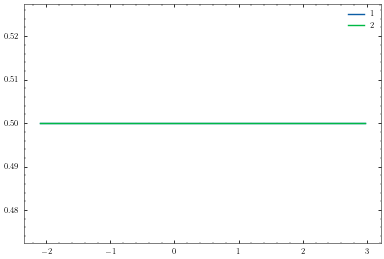
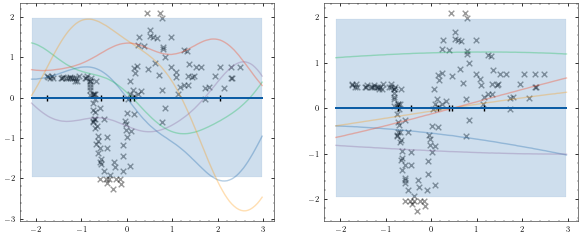

We must now convert our numpy data set into a TensorFlow data set and set it up for stochastic optimisation by setting the batch size. We set drop_remainder=True to ensure the model receives the batch size.
[12]:
prefetch_size = tf.data.experimental.AUTOTUNE
shuffle_buffer_size = num_data // 2
num_batches_per_epoch = num_data // batch_size
train_dataset = tf.data.Dataset.from_tensor_slices(dataset)
train_dataset = (train_dataset.repeat().prefetch(prefetch_size).shuffle(
buffer_size=shuffle_buffer_size).batch(batch_size, drop_remainder=True))
We then use GPflows training_loss_closure method to get our training loss.
[13]:
training_loss = model.training_loss_closure(iter(train_dataset))
In mogpe.training.training_loops some training loops are defined. Here we use the simple training_tf_loop which runs the Adam optimizer on model with training_loss as the objective function. The loop does not use any TensorBoard monitoring. We first configure the training/logging parameters.
[14]:
logging_epoch_freq = 5
plotting_epoch_freq = 500
num_epochs = 2500
[15]:
def plot_elbo(elbo):
plt.subplot(111)
plt.scatter(np.arange(len(elbo))*logging_epoch_freq, elbo)
plt.xlabel("Epoch")
plt.ylabel("ELBO")
[16]:
optimizer = tf.optimizers.Adam(learning_rate=learning_rate)
@tf.function
def tf_optimization_step():
optimizer.minimize(training_loss, model.trainable_variables)
elbo_log = []
for epoch in range(num_epochs):
for _ in range(num_batches_per_epoch):
tf_optimization_step()
epoch_id = epoch + 1
if epoch_id % logging_epoch_freq == 0:
elbo_log.append(training_loss()*-1.0)
if epoch_id % plotting_epoch_freq == 0:
clear_output(True)
tf.print(f"Epoch {epoch_id}: ELBO (train) {training_loss()}")
plot_elbo(elbo_log)
plt.show()
Epoch 2500: ELBO (train) -12.587674046751173
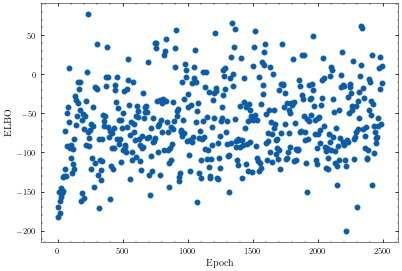
Now that we have trained the model we can use our plotter again to visualise what we have learned.
[17]:
plotter.plot_model()
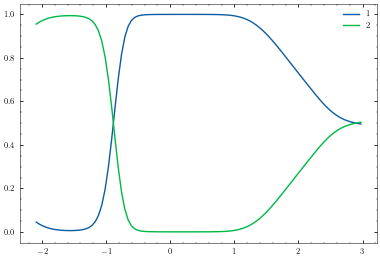
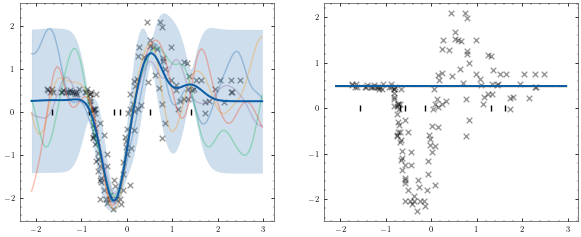
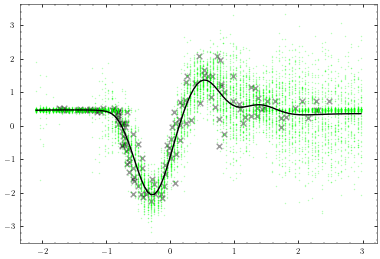
[18]:
print_summary(model, fmt="notebook")
| name | class | transform | prior | trainable | shape | dtype | value |
|---|---|---|---|---|---|---|---|
| MixtureOfSVGPExperts.gating_network.kernel.variance | Parameter | Softplus | True | () | float64 | 10.044302011299953 | |
| MixtureOfSVGPExperts.gating_network.kernel.lengthscales | Parameter | Softplus | True | () | float64 | 0.9191759962241284 | |
| MixtureOfSVGPExperts.gating_network.inducing_variable.Z | Parameter | Identity | True | (7, 1) | float64 | [[-0.33679763... | |
| MixtureOfSVGPExperts.gating_network.q_mu | Parameter | Identity | True | (7, 1) | float64 | [[1.23060906... | |
| MixtureOfSVGPExperts.gating_network.q_sqrt | Parameter | FillTriangular | True | (1, 7, 7) | float64 | [[[0.24373665, 0., 0.... | |
| MixtureOfSVGPExperts.experts.experts_list[0].mean_function.c | Parameter | Identity | True | (1,) | float64 | [0.2537413] | |
| MixtureOfSVGPExperts.experts.experts_list[0].kernel.variance | Parameter | Softplus | True | () | float64 | 0.7245331900215413 | |
| MixtureOfSVGPExperts.experts.experts_list[0].kernel.lengthscales | Parameter | Softplus | True | () | float64 | 0.266099322492376 | |
| MixtureOfSVGPExperts.experts.experts_list[0].likelihood.variance | Parameter | Softplus + Shift | True | () | float64 | 0.10439134246880631 | |
| MixtureOfSVGPExperts.experts.experts_list[0].inducing_variable.Z | Parameter | Identity | True | (6, 1) | float64 | [[-0.82094873... | |
| MixtureOfSVGPExperts.experts.experts_list[0].q_mu | Parameter | Identity | True | (6, 1) | float64 | [[-0.22453415... | |
| MixtureOfSVGPExperts.experts.experts_list[0].q_sqrt | Parameter | FillTriangular | True | (1, 6, 6) | float64 | [[[0.14292316, 0., 0.... | |
| MixtureOfSVGPExperts.experts.experts_list[1].mean_function.c | Parameter | Identity | True | (1,) | float64 | [0.47905155] | |
| MixtureOfSVGPExperts.experts.experts_list[1].kernel.variance | Parameter | Softplus | True | () | float64 | 1.875849923049286e-07 | |
| MixtureOfSVGPExperts.experts.experts_list[1].kernel.lengthscales | Parameter | Softplus | True | () | float64 | 14.49029624682839 | |
| MixtureOfSVGPExperts.experts.experts_list[1].likelihood.variance | Parameter | Softplus + Shift | True | () | float64 | 0.001153125667128228 | |
| MixtureOfSVGPExperts.experts.experts_list[1].inducing_variable.Z | Parameter | Identity | True | (6, 1) | float64 | [[-1.55605991... | |
| MixtureOfSVGPExperts.experts.experts_list[1].q_mu | Parameter | Identity | True | (6, 1) | float64 | [[-0.00318104... | |
| MixtureOfSVGPExperts.experts.experts_list[1].q_sqrt | Parameter | FillTriangular | True | (1, 6, 6) | float64 | [[[-1.01888223e+00, 0.00000000e+00, 0.00000000e+00... |
[ ]: